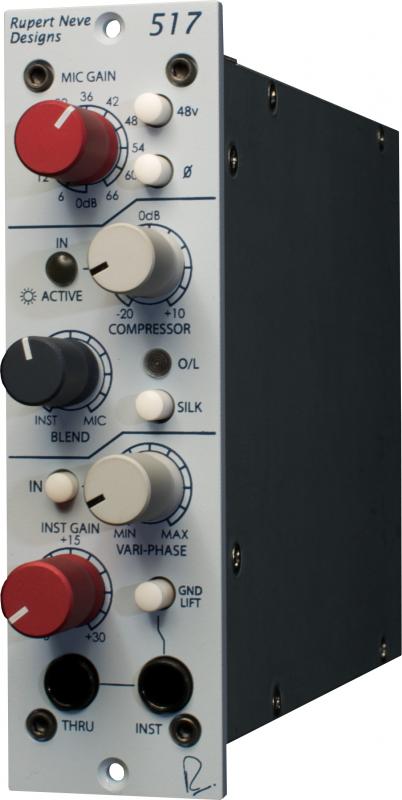TABLE
TR
TDATTACH1233.vBATTACH
TD
TDB500 Series DIPreComp with VariphaseB
Based on the Portico 5017 Mobile Pre, the BRupert Neve Designs Portico 517B provides world class, transformer-coupled preamp, compressor and DI circuitry, with Vari-phase, Silk and DImic blending capabilities in a 500 series model. As the first 500 series module designed by Mr. Rupert Neve, the 517 incorporates outstanding sonic quality with an indispensable feature set.
TD
TR
TABLE
BMic Pre and Instrument AmplifierB
The 517′s mic preamp includes 66dB gain, and is based on the Portico 5017 design. The mic preamp also incorporates a polarity reverse switch and phantom power. The separate instrument amplifier includes 30dB of gain, a ground lift, variable phase and an instrument Thru connection.
Blended Use
Used as a single channel device for instruments, the 517 can be used to phase align, combine and compress direct and amplified signals. To achieve this, use the DI for the instrument's direct signal and the mic preamp for the speaker cabinet signal. The blend control is used for mixing direct and amplified signals to achieve the desired tonal blend between the two sources, and the variphase is used to minimize or extenuate phase cancellations between the two signals. To compress the blended signal, the internal compressor jumper must be set to the blend path (this is the default setting). This technique could also be used to create a single, mixed output of a guitar and vocals.
BThe CompressorB
Based around a new LDR (light dependent resister) design, the 517′s opto-coupler compressor has been simplified to a single threshold control with auto make up gain. By default, the compressor is set to a fixed 2:1 ratio with fixed attack and release. To set the compressor, simply dial the threshold control down until the desired amount of compression is achieved. An LED light indicates when the compressor is active.
BVari-PhaseB
In addition to the standard polarity reverse, the 517′s vari-phase control may be used to adjust phase incrementally. This control is useful any time two signals derived from the same source are combined.
For instance, even with careful placement, the combination of close miced drums and overheads, can often yield hollow sounding results. By using the variable phase adjust, the direct signal can be phase rotated until the signals are naturally aligned.
This technique is also extremely useful when combined with the internal blend control on instruments. A bassist, using both direct and miced signals can blend the two into a single output, using the vari-phase to reach an optimal alignment. By adjusting the phase in the 517, the musician or engineer can find the absolute best mic position without regard to the phase relation to the direct signal.
h=3Rupert Neve Designs Portico 517's featureshBSilkB
Much could be written about this feature, suffice to say, that it gives a subtle option to enhance sound quality in the direction of vintage modules. The silk button reduces negative feedback and adjusts the frequency spectrum to provide a very sweet and musical performance. We suggest you try it and make your own judgment.
BMic GainB
Mic gain is from 0dB to 66dB. Overall gain to restore the apparent program level
BDI GainB
DI Gain is from 0dB to 30dB
BDI inputB
Balanced or unbalanced Hi-Z input for instruments
BPhantom powerB
Provides 48v phantom power to microphones. Controlled by the 48V switch.
BPolarity reverseB
Reverses the polarity of the mic input
BThresholdB
When signals exceed the "threshold" level, the gain is reduced at a controlled 2:1 ratio, with fixed attack and release time constants.
BIndicatorsB
Indicators on the 517 denote signal presence and clipping on both DI and mic signals, as well as compressor activation.
h=3Rupert Neve Designs Portico 517's specificationshBFrequency Response:B
Main Output, no load, –0.2 dB @ 10 Hz –3 dB @ 160 kHz
BNoise:B
Measured at Main Output, unweighted, 22Hz-22kHz, Terminated 150 Ohms. With gain at unity better than –100 dBu With gain at 66 dB better than –62 dBu Equivalent Input Noise better than –128 dBu
Noise Factor 1.5dB
BMaximum Output Level:B
Maximum output from 20 Hz to 40 kHz is +23 dBu.
BTotal Harmonic Distortion and Noise:B
@ 1kHz, +20 dBu output: Main Output: Better than 0.001% @ 20Hz, +20 dBu output: Main Output: Better than 0.002% Silk Engaged: Better than 0.2% Second harmonic
BCrosstalk:B
Measured channel to channel: Better than –90 dB @ 15kHz.
BPhantom Power:B
+48 Volts DC +- 1%
